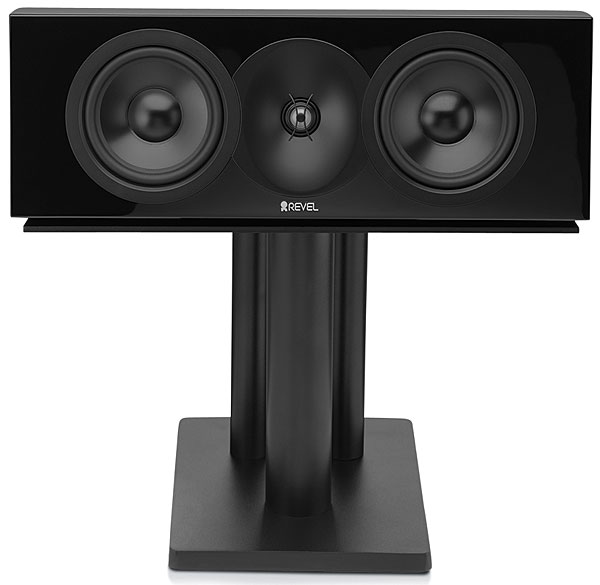Revel Concerta2 M16 Speaker System Review

AT A GLANCE
Plus
High transparency
Equalized subwoofer
Wall-hanging surrounds
Minus
Manual sub EQ requires expertise
THE VERDICT
Revel draws on Harman’s world-class engineering depth to produce immaculate high-end sound—this time, at an extremely reasonable price.
Audiophiles (myself included) often point out that high-end audio is stigmatized compared with other product categories. High-end cars, high-end wine, high-end watches: All attract aficionados who don’t mind paying a stiff premium to get the best of the best. And if an average onlooker ventures an opinion at all, it’s “nice watch!” But when a bleeding-edge speaker or amp takes the stage, the applause of the cognoscenti mixes with heckling from the peanut gallery. High-end audio has long been subject to that extra measure of skepticism.
To survive and prosper in this distrustful environment, a high-end audio manufacturer must not only make high-achieving products, but do it consistently. That is what has made Revel, Harman International’s top speaker brand, a long-term success. From day one, it has drawn on the parent company’s deep engineering expertise and worldclass facilities (including an anechoic chamber to measure and refine its designs). Revel products tend to be carefully thought out and well made, and they’ve stayed that way for two decades.
New Concerta2
Revel’s three top speaker lines are the Ultima2, Performa3, and the new Concerta2. Each of them accommodates home theater by offering at least one center speaker; the Performa3 series also features a dedicated surround. Then there are Revel’s other lines: on-wall Concerta, in-wall and in-ceiling Architectural, and outdoor Extreme Climate. A recent overhaul of the Concerta2 brings two towers, the F36 ($2,000/pair and recently reviewed by Tom Norton) and F35 ($1,600/pair), along with the M16 monitor ($900/pair), C25 center ($750), S16 on-wall ($900/pair), and B10 subwoofer ($1,500). This review brings together all but the towers and uses a pair of the on-walls as surround speakers.
Several design features of the Concerta2 hail from the Performa3 line. They include 1-inch aluminum dome tweeters with integral phase rings and acoustic lens waveguides, Micro-ceramic Composite (MCC) cone woofers that are said to provide less mechanical breakup and lower mass, and computer-optimized driver positioning and crossover networks. Enclosures are constructed from three-quarter-inch fiberboard with curved sides to reduce internal standing waves and windowpane bracing to reduce cabinet resonances and the resulting sonic coloration.

Woofer sizes are 6.5 inches for the M16 monitor and S16 on-wall and 5.25 inches for the pair in the C25 center. The B10 sub has a single front-firing fiber-composite-cone 10-inch woofer in a die-cast frame, with a beefy 800-watt Class D amplifier. Monitor and sub enclosures are ported, while center and surround are sealed. There are no visible fasteners on any of the speaker baffles. Grilles attach magnetically except on the sub. Although the C25 center doesn’t claim dual status as a left/right speaker, the S16 is for both surround and LCR applications; theoretically, you might use five or more in an entirely on-wall system. The S16 has an enclosure that narrows from back to baffle, so its 5-inch depth looks minimal.
All of these speakers have a nominal impedance of 6 ohms. Rated sensitivity is 86 decibels for the monitor, 89 for the center, and 90 for the surround. This suggests that a midpriced-and-up receiver might work, though separates might work better—not only for oomph, but for reduced distortion, as these are fearlessly high-resolution speakers. My review setup tread the middle path with a top-line receiver.

Normally, I’d use an 80-hertz crossover for speakers of this size. For the monitor—which reaches its –3-dB point at 55 Hz, according to manufacturer ratings (you may double-check our Test Bench measurements)—that’s a safe choice. However, the center reaches its –3-dB point at 80 Hz, which would leave a small bass underlap with my usual crossover. The surround reaches –3 dB at 70 Hz. My receiver allows separate crossover settings for each speaker or pair, so I used 80 Hz for the monitors, 100 for the center, and 90 for the surrounds (probably an excess of caution).
That brings us to a related subject. The B10 subwoofer is an equalized sub and therefore can be tailored for the room in ways impossible with a conventional sub. Even audiophiles who look askance at full-system equalization favor it for a sub. There’s no downside to sub EQ; you can always toggle it off if you don’t want to use it. Maybe your room enables perfect bass response, requiring nothing more than careful positioning of the sub. Most spaces, however, have room for improvement, so you’ll want to work on those EQ settings.






























































